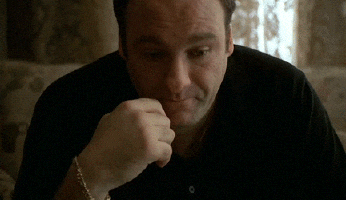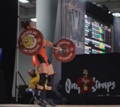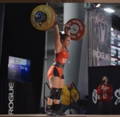Weightlifting Competition Planning and Preparation
A lot of weightlifting coaches will get into weightlifting competitions with their athletes and not have any plan. The athletes are coming in blindfolded with coaches saying, “Just trust me, I’ve got everything figured out. Don’t worry about it.” That doesn’t work. What ends up happening is, when things start to go wrong or things need to be rushed, no one is in tune with what the plan is causing a lot of anxiety and tension to rise to the surface. This heightened anxiety and tension lead to more stress, bad warm-ups, and bad attempts. All of a sudden, the entire competition plummets because of a lack of planning.

Think of the greatest coaches in the world. For instance, the football coach Nick Saban. When he is going into a major competition or any game for that matter, he has a game plan. He has an understanding of his opponents’ tendencies. He rolls through everything with his own team, doing walk-throughs prior to the game. He and his players understand what the game plan is going to be and how they will adapt at half-time.
Weightlifting coaches have to take this skill set of game planning prior to competing away from other sports. We have to be better about our game plan, understanding what our attempts will be, understand the progressions, and know what to do at various points of the competition.
We are going to look at a specific competition from 2019 at the American Open out in Utah in which Kate Wehr, who qualified for the Junior World Team (canceled because of Covid), ended up going 6/6 and lifting very well as a 59 K lifter. She ended up snatching 83 kilos and clean and jerking 104 kilos. She was number 3 on that world team. She is now twenty-one years old and has snatched 93 kilos and clean and jerked 112 kilos, continuing to steamroll the platform.
Let’s analyze this specific competition, how we went through the warm-ups and what we thought about while doing it.
1. Cues
After her bar work and general workout, Kate’s first attempt in the back snatching was 45 kilos, then 55 kilos. She then progressed to 60 kilos. 65 kilos was her fourth attempt in the back--she was a little bit off on the catch so I cued her on that.

One of the big errors I see coaches is they don’t talk to their athletes about specific cues. That is one of the first key factors. Coaches have to have one or two cues to roll with. One cue needs to be technical. The other cue needs to be more directional, motivational, like, “Smash that finish.” The technical cue can be something like, “Knees back more off the floor.” Just keep the cues simple to make the line of communication clear between the coach and athlete.
2. Minimize Stress
I and Kate knew she was opening at 77 kilos. We knew the last warm-up, and the three leading to that, I have no issue with being precise with weight on the bar: 69, 72, 75 for instance. But prior to that, I will see coaches put on 47 kilos, 63 kilos, and it is like why are you doing that? Just go 45, 55, 60, 65, something along those lines to make it easier to load the bar. If we are always looking for the little factional plates it becomes more challenging and increases the stress in the back.

It is key to minimize the stressors as a coach to be in tune with the board, how the athlete is lifting, and how to cue them properly.
3. Routine Between Lifts
Kate was forward on her pull with 72 kilos in the back. We had to share the bar, so we loaded 75 kilos a little funky. On this warm-up attempt, she improved but was still a little shaky overhead.
One of the hardest parts of this specific competition is that I had one person loading for me who was also filming. It created a challenge to load, count, and cue all at the same time, especially in a high-pressure situation. Kate handled it really well.
From there, Kate comes out and opens up at 77 kilos. Recently, at a local competition, Kate opened up at 87 kilos. Shows how far she has come in nineteen months! Anyway, Kate smashes 77 kilos out on the platform. Nice and tight off the floor, good tight catch.
This is when the next key factor comes into play. As coaches, we need to have a routine with our athletes. Our athletes have to know what happens if we are waiting too long between attempts. Now with the snatch, it isn’t as large of a concern because the load is a little lighter, where the clean and jerk is heavier and can be more challenging.
We need to be aware when the athlete is sitting too long between attempts. We need to establish if the athlete will take a power, a full, or a pull. It is up to the athlete; it is not up to the coach. Go with what the athlete wants.
Kate’s next attempt at 80 kilos on her second attempt was a success.
4. Don’t Take Crazy Risks During The Snatch
I think that when taking snatches it is about coming out of the snatch with an extra kilo at most. Take it for what it is. Ideally, athletes go 3 for 3, with as many kilos as possible but with no crazy jumps. Where ground can be made up is in the clean and jerk. If crazy jumps need to be made to win it, those crazy jumps are taken in the clean and jerk.

As coaches, we need to know this while taking attempts in the snatch.
Kate went out and hit 83 kilos on her third attempt.
5. Purpose Of The Meet
For the clean and jerk, Kate went 55 kilos, 65 kilos, and into 75 kilos. We went from there right to 85 kilos. A lot of people don’t like to do that. But when we have an athlete who has clean and jerked well over 100 kilos, it is good to do that. It makes the timing easier and helps the athlete get into a good rhythm with their warm-up.
One thing I noticed is that Kate started to get narrow in her split. So I gave her short and established cues.
The purpose of this specific meet was to qualify for the Junior World Team. Kate knew things were going to get intense and I was going to push the attempts. Having this in the back of the mind, the athlete knowing what to expect, we end up opening so heavy (at 98 kilos for this competition) plays head games with the competition.
Like when Kate went to 94 kilos in the warm-up area, which was part of our plan, had her closest competitor trying to hang with her, seeing what was going on. We can throw off other people’s games by having our plan that is able to be adapted a little bit here and there.
6. Getting In The Game
The first attempt on the platform is to get three white lights and get in the game. It should be a weight that the athlete has hit for a double and can push pretty hard. This establishes a score to stay in the competition and gives room to win.
The second attempt is right around the PR or a little below. The third attempt is to go for broke to win the title, make the team, or whatever the far-reaching goal is. Just make sure to keep the cues simple. Don’t be the coach saying nine things.

We don’t want the athlete thinking about nine different things. We want the athlete confident and feeling good.
Thinking back, when Kate came out for her second clean and jerk attempt, I started to feel pretty good. She came out at 101 kilos and, though a little behind in the clean, she smashed the jerk. This put Kate in a position to take one big lift. She had her spot locked up on the team and things were going well. I was a little anxious but hid this from Kate by getting out of her line of sight. This is small but important because the more confidence you have as a coach the more confidence you can put onto your athlete.
Kate went out for her last attempt at 104 kilos. In this position, looking at the coaching card and seeing things working out, we were excited. Kate had a better catch in the clean, smashed the jerk, and completed a great lift and great competition.
Recap
With a weightlifting competition, coaches and athletes have to plan ahead, meet ahead (the day before, and the day of), and we even plan ahead/meet three weeks out to start to take the jumps in training. I will even factor in different jumps on one day so the athlete can get used to different styles of jumps. I will even play around with timing. I have athletes that can sit for five minutes and be fine and others who need to go within three minutes. These situations need to be practiced in training.
At the very least, know the attempts, know the athlete, know the cues, and focus on YOUR plan, and don’t worry about others.
DANE MILLER
Dane Miller is the owner and founder of Garage Strength Sports Performance. He works with a select handful of clients on building comprehensive programs for fitness and nutrition. Several times a year he leads a workshop for coaches, trainers, and fitness enthusiasts.


